10 Protein
Learn
- The function of proteins
- Impact of too little or too much protein in your diet
- Best food sources for protein
- Essential and nonessential amino acids
- Complementary proteins
Introduction to Protein
Protein makes up approximately 20 percent of the human body and is present in every single cell. The word protein is a Greek word, meaning “of utmost importance.” Proteins are called the workhorses of life as they provide the body with structure and perform a vast array of functions. You can dance, run, play racquetball, hula-hoop, and more because of your protein-rich muscles. Protein is necessary for proper immune system function, digestion, hair and nail growth, and numerous other body functions. In fact, it is estimated that more than one hundred thousand different proteins exist within the human body. In this chapter, you will learn about the components of protein, the important roles that protein serves within the body, how the body uses protein, the risks and consequences associated with too much or too little protein, and where to find healthy sources in your diet.
What is Protein?
Proteins, simply put, are macromolecules composed of amino acids. Amino acids are commonly called protein’s building blocks. Proteins are crucial for the nourishment, renewal, and continuance of life. Proteins contain carbon, hydrogen, and oxygen just as carbohydrates and lipids do, but proteins are the only macronutrient with nitrogen.
Watch the video on Proteins to learn how protein is used in your body
Sources of Protein
The protein food group consists of foods made from meat, seafood, poultry, eggs, soy, beans, peas, nuts, and seeds. Animal protein and vegetable protein provide different nutrients for the body. They contain other vitamins and minerals as well as different kinds of fat. Protein-rich animal-based foods commonly have high amounts of B vitamins, vitamin E, iron, magnesium, and zinc. Seafood often contains healthy fats. Plant sources of protein contain a high amount of fiber. Some animal-based protein-rich foods have an unhealthy amount of saturated fat and cholesterol, so it is important to be mindful of how much of one source of protein you are consuming. It is best to vary protein sources to help the body receive an adequate diet of different nutrients.
Examples of protein-rich foods like fish, poultry, lentils, and tofu.
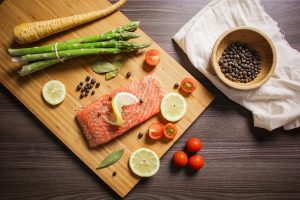 |
 |
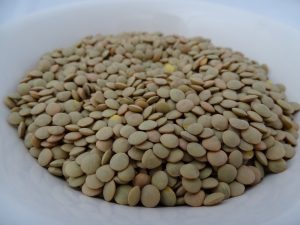 |
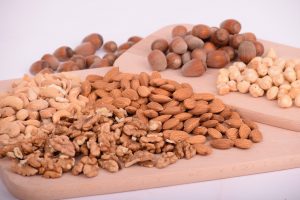 |
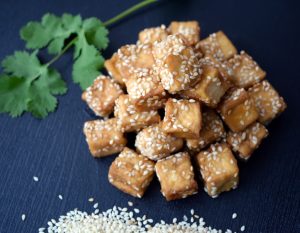 |
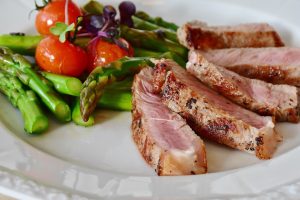 |
We cannot make essential amino acids in the body, so we need to get them in our diet. When a food item contains all nine amino acids, it is called a complete protein. Some examples of complete protein foods would be meat, quinoa, eggs, and soybeans. We can combine two incomplete food items to make a complete protein. Some examples are beans and rice, peanut butter on toast, and a salad with chickpeas and sunflower seeds. For more ideas with complementary foods, visit: https://health.bastyr.edu/news/health-tips/2019/05/what-are-complementary-proteins-and-how-do-we-get-them
Essential Amino Acids |
NonEssential Amino Acids |
| Histidine | Alanine |
| Isoleucine | Arginine* |
| Leucine | Asparagine |
| Lysine | Aspartic acid |
| Methionine | Cysteine* |
| Phenylalanine | Glutamic acid |
| Threonine | Glutamine* |
| Tryptophan | Glycine* |
| Valine | Proline* |
| Serine | |
| *Conditionally Essential | Tyrosine* |
What are essential, nonessential, and conditionally essential amino acids?
Directions: Fill in the blanks with the correct number of essential, nonessential, and conditionally essential amino acids. Then fill in the blanks with the definition for essential, nonessential, and conditionally essential amino acids.
Do You Know?
Watch the video below, “From DNA to protein – 3D,” to help you learn the process of building proteins. The three key steps are:
- Transcription
- Translation
- Folding
Important Roles of Protein in the Body.
Proteins are the “workhorses” of the body and participate in many bodily functions. Proteins come in all sizes and shapes, and each is specifically structured for its particular function:
- Structure and Motion: more than one hundred different structural proteins have been discovered in the human body, but the most abundant by far is collagen, which makes up about 6 percent of total body weight. Collagen makes up 30 percent of bone tissue and comprises large amounts of tendons, ligaments, cartilage, skin, and muscle. Collagen is a strong, fibrous protein made up of mostly glycine and proline amino acids. Within its quaternary structure, three protein strands twist around each other like a rope, and then these collagen ropes overlap with others. This highly ordered structure is even stronger than steel fibers of the same size. Collagen makes bones strong but flexible. Collagen fibers in the skin’s dermis provide it with structure, and the accompanying elastin protein fibrils make it flexible. Pinch the skin on your hand and then let go; the collagen and elastin proteins in the skin allow it to go back to its original shape. Smooth-muscle cells secrete collagen and elastin proteins surround blood vessels, providing the vessels with structure and the ability to stretch back after blood is pumped through them. Another strong, fibrous protein is keratin, which is what skin, hair, and nails are made of.
Amino Acid Refresh
Directions: Complete the statement below by filling in the blanks.
- Enzymes: Although proteins are found in the greatest amounts in connective tissues such as bone, their most extraordinary function is enzymes. Enzymes are proteins that conduct specific chemical reactions. An enzyme’s job is to provide a site for a chemical reaction and to lower the amount of energy and time it takes for that chemical reaction to happen (this is known as “catalysis”). On average, more than one hundred chemical reactions occur in cells every single second, and most of them require enzymes. The liver alone contains over one thousand enzyme systems. Enzymes are specific and will use only particular substrates that fit into their active site, similar to how a lock can be opened only with a specific key. Nearly every chemical reaction requires a specific enzyme. Fortunately, an enzyme can repeatedly fulfill its role as a catalyst, although it is eventually destroyed and rebuilt. All bodily functions, including the breakdown of nutrients in the stomach and small intestine, transforming nutrients into molecules a cell can use, and building all macromolecules, including protein itself, involve enzymes.
- Hormones: proteins are responsible for hormone synthesis. Hormones are the chemical in the body that communicates a message to initiate a specific reaction or cellular process. For instance, after you eat a meal, your blood glucose levels rise. In response to the increased blood glucose, the pancreas releases the hormone insulin. Insulin tells the body cells that glucose is available and takes it up from the blood and stores it or uses it to make energy or build macromolecules. A major function of hormones is to turn enzymes (and therefore processes) on and off. While not all hormones are made from proteins, many of them are.
- Fluid and Acid-Base Balance: The body is in an ever-changing environment. Eating enough protein helps the body maintain balance. Fluid balance refers to maintaining the distribution of water in the body. If too much water in the blood suddenly moves into a tissue, the results are swelling and, potentially, cell death. To keep the water evenly distributed between blood and cells, proteins continuously circulate in the blood. The most abundant protein in blood is the butterfly-shaped protein known as albumin. Albumin’s presence in the blood makes the protein concentration in the blood similar to that in cells. Therefore, fluid exchange between the blood and cells is not extreme but rather minimized to preserve the status quo. Protein is also essential in maintaining proper pH balance (how acidic or basic a substance is) in the blood. Even a slight change in blood pH can affect body functions. The body has several systems that hold the blood pH within the normal range to prevent this from happening. One of these is the circulating albumin. Albumin acts as a buffer against abrupt changes in molecules’ concentrations, thereby balancing blood pH and maintaining the status quo. The protein hemoglobin also participates in acid-base balance.
True/False – What do proteins contain again?
- Transport: proteins serve to transport molecules around the body and through cell membranes. Proteins can either carry, like a taxi, the molecule (passenger) through the membrane, or the protein can be a fixed tunnel in the side of the membrane, which a molecule can pass through easily like a pedestrian walking through a tunnel built under a road, allowing them safe passage from one side of the road to the other.
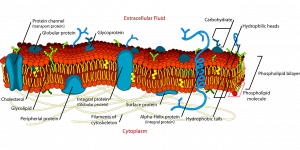 Molecules move in and out of cells through transport proteins, which are either channels or carriers.
Molecules move in and out of cells through transport proteins, which are either channels or carriers.
6. Protection: proteins play an important role in protecting the body against unwanted intruders, from building the strong collagen fibers in the skin to provide it protection from the world, to be the chemicals that the immune system uses to attack and destroy invaders. You’ve heard of antibodies: they are proteins that seek and destroy invaders in the system.
7. Wound Healing and Tissues Regeneration: Proteins are involved in all aspects of wound healing. If a diet is insufficient in protein, the process of wound healing is markedly slowed. Tissue regeneration is when there is no wound, and it’s just the regular maintenance of the body. For example, skin cells are constantly dying. They are not replaced by scar tissue but instead by new identical skin cells. The same is true for cells lining the digestive tract, which are replaced every 3-5 days. Protein-inadequate diets impair tissue regeneration, causing many health problems, including impairment of nutrient digestion and absorption and, most visibly, hair and nail growth.
8. Energy Production: protein can be used for energy if necessary due to a lack of carbohydrates or fats.
Did You Know?
Watch the video below on wound healing.
Test Your Knowledge about Cell Regeneration
After watching the wound healing video and reading the text, complete the activity below by dragging the cells to their correct box on which they regenerate at a high rate or not.
Why You Should Eat Protein
Protein deficiency syndromes are a leading cause of death in children under five in poor, underdeveloped countries. Protein deficiency can cause swelling, fatigue, skin problems, irritability, muscle wasting, and eventual death from infection. A severe form of protein malnutrition is called kwashiorkor. 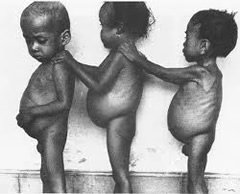 This is characterized by potbelly stomachs relating to an imbalance of osmotic solutions. You can see an example pictured to the right. The long-term health consequences of high-protein diets have not been adequately studied. As with any nutrient, protein must be eaten in proper amounts. Moderation and variety are key strategies for achieving a healthy diet and need to be considered when optimizing protein intake. Eat proteins in moderation, at least 10 percent of the calories you take in and not more than 35 percent. A simple calculation for protein intake is to take your weight in kilograms (weight in pounds divided by 2.2) and multiply it by 0.8 to get the total grams of protein needed for a normal healthy adult each day based on the RDA. For example, if you weigh 165 lbs, we can convert it to kg by dividing by 2.2; 165 lbs / 2.2= 75 kg. If you weigh 75 kg and protein recommendations are 0.8 g/kg, we can do the math; 75 kg x 0.8 = 60 g of protein per day based on recommendations. Too little protein impairs bodily functions, and too much may lead to chronic disease. Protein deficiency is not a concern for most Americans as protein consumption is typically greater than need on a daily basis.
This is characterized by potbelly stomachs relating to an imbalance of osmotic solutions. You can see an example pictured to the right. The long-term health consequences of high-protein diets have not been adequately studied. As with any nutrient, protein must be eaten in proper amounts. Moderation and variety are key strategies for achieving a healthy diet and need to be considered when optimizing protein intake. Eat proteins in moderation, at least 10 percent of the calories you take in and not more than 35 percent. A simple calculation for protein intake is to take your weight in kilograms (weight in pounds divided by 2.2) and multiply it by 0.8 to get the total grams of protein needed for a normal healthy adult each day based on the RDA. For example, if you weigh 165 lbs, we can convert it to kg by dividing by 2.2; 165 lbs / 2.2= 75 kg. If you weigh 75 kg and protein recommendations are 0.8 g/kg, we can do the math; 75 kg x 0.8 = 60 g of protein per day based on recommendations. Too little protein impairs bodily functions, and too much may lead to chronic disease. Protein deficiency is not a concern for most Americans as protein consumption is typically greater than need on a daily basis.
What about vegetarians and vegans
People who consume a vegetarian and vegan diet may be at risk of lower protein intake. There are different levels of vegetarianism, and some may be at greater risk. Lacto vegetarians only consume dairy from animal sources like milk, cheese, or yogurt. Lacto-Ovo vegetarians consume dairy and eggs from animals. Pescatarians will consume fish and seafood on top of dairy and eggs. Eating a wider variety of protein-rich foods helps provide the body with essential nutrients. One nutrient that is very common to be low with vegetarians and vegans is vitamin B12. This is essential for keeping blood, nerves, and DNA healthy. Without animal products, vitamin B12 consumption may be low, so it is important to speak with a health care professional about supplementation or consuming a high fortified diet.
While there may be challenges when following a vegetarian diet, a diet that is varied and balanced has been shown to reduce the risk of chronic diseases. Nutritional benefits from a vegetarian diets may include:
- Reduced risk for some cancers – associated with higher fiber intake.
- Fewer digestive issues – associated with higher fiber intake.
- Reduced risk of kidney diseases – associated with higher intake of vegetable proteins (legumes, soy).
- Reduced risk for heart disease – associated with decreased saturated fat intake.
- Lower blood pressure – associated with increased intake of fruits and vegetables.
Athletes and Protein intake
For an athlete, those following an omnivorous, vegetarian, or vegan diet should aim to consume 1.2-2.0 g/kg/day of protein to help support muscle repair and turnover. For more information about protein intake with athletes, visit https://www.gssiweb.org/sports-science-exchange/article/vegetarian-and-vegan-diets-for-athletic-training-and-performance
Learning Objectives
- Define the roles of protein in the body. (MCCCD Competency 5)
- Identify your protein needs. (MCCCD Competency 1)
- Discuss the differences between animal and vegetable-based protein sources. (MCCCD Competency 1)
- Define a complete protein. (MCCCD Competency 5)
- Define essential and nonessential amino acids. MCCCD Competency 5)
- Discuss the disorders of too much and too little protein in the diet. (MCCCD Competency 9)

